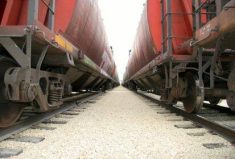A senior executive with CP Rail says the company is “well positioned” to move this year’s grain crop despite recent cutbacks in staff and locomotives.
Grain is, was and will continue to be Canadian Pacific Railway’s biggest cargo, John Brooks, vice-president of sales and marketing for bulk commodities, said in an interview Aug. 6.
And the historic railway founded in 1881 is investing to move even more in the future, he said. “Make no bones about it, grain is king at CP,” he said.
“It is our life-bread. There is nothing we want to do more than move a lot of grain.
“I think we feel pretty good about our handling capacity… to move this new crop.”
That’s welcome news to the Western Grain Elevator Association (WGEA), which represents the West’s main grain companies, but the association is uneasy, said executive director Wade Sobkowich. CP Rail is cutting 300 employees and idling 20 per cent of its locomotives and cars due to a drop in business, chief operating officer Keith Creel told reporters last month.
Read Also

CUSMA access key among other trade noise: Seeds Canada panel
Seeds Canada conference panelists say Canada needs to stay focused and wait as U.S. trade and tariff chaos develops, and a Canada-U.S.-Mexico Agreement review looms
“We’re just a month away from the highest-demand months (for cars) and we see information that CP is cutting back on crews, cars and locomotives,” Sobkowich said. “That doesn’t fit.
“On the surface it looks like rail services are being removed not added to.”
When asked later about CP’s cuts, Brooks responded in an email the railway is “well positioned” to move this year’s crop, which is expected to be about average in size. “The vast majority of the recently announced headcount reductions are at the management level and will not impact CP’s ability to move grain.”
CP, he said, “is nimble and able to efficiently adjust assets to match sustained business levels. CP is well positioned to provide best-in-class service to western Canadian grain shippers during the 2015-16 crop year, so long as the balance of the supply chain does their part to move grain as efficiently as possible.”
The WGEA doesn’t want a repeat of the 2013-14 crop year when grain shipments fell so far behind the federal government ordered the railways to ship minimum volumes or be fined.
University of Saskatchewan agricultural economist Richard Gray estimates the gap between port and inland grain prices due to the backlog cost farmers around $5 billion over two crop years.
The railways blamed a record 77-million-tonne crop and bad winter weather. Farmers and the WGEA accused the railways of not investing in surge capacity knowing grain was captive and therefore would move when the railways got to it.
In the 2014-15 crop year that ended July 31 CP Rail moved a record 27.85 million tonnes of Canadian grain and grain products from Western Canada. And the company is investing to move more, Brooks said.
Over the next three to five years the railway plans to double its capacity on two of its major corridors — Winnipeg to Edmonton and Moose Jaw to Minneapolis-St. Paul — in anticipation of increasing western Canadian grain production, especially if corn spreads west. It will do it by running more trains, longer trains and at higher speeds with innovations such as central traffic control, which schedules trains to maximize throughput, investing in heavier steel rails, newer ties, more and longer sidings and buying bigger hopper cars.
“It’s all these components that give you a big lift in capacity,” Brooks said.
It takes 100 trains with 112, 90-tonne cars to move one million tonnes of grain, Brooks said. Haul 134 cars and it takes 83 trains. If the cars hold 100 tonnes instead of 90 it drops to 75.
“That’s our model at Canadian Pacific,” Brooks said.
“That should translate into growth for the shippers and hopefully benefit producers.”
CP Rail is also communicating better with shippers and farmers “so we know what to move and know what the expectations are.”
Last crop year CP Rail used “dedicated trains” to haul most of its grain. Grain companies and CP Rail agree up front how many trains the company will receive over an entire crop year. The company then knows how much grain it can sell.
“If you talk to the shippers I think it has been a big success,” Brooks said.
And there’s more. New country elevators on CP lines are expected to load a minimum of 134-car trains, up from 100 or 112, while existing terminals will be encouraged to expand car spots. New elevators will load cars faster so CP can leave its locomotives running and move out quicker.
“We’re working with all the major grain shippers… to really look at our origin infrastructure… to develop facilities capable of loading fast, dumping trucks fast from producers…”
This year CP Rail will spend $1.5 billion on its network, which is about 21 per cent of its revenue and, according to Brooks, more than what any other Class 1 railway is investing.
Vancouver is a world-class port, but it’s congested, Brooks said. CP Rail is working with port terminals to be more efficient In the 2014-15 crop year that ended July 31, CP Rail unloaded a record 148,000 cars of grain and grain products in Vancouver, he said.
“That wouldn’t happen if we weren’t working closely with the shippers to get it done.”
CP Rail’s unloads at Thunder Bay were the second highest on record, he added.
CP Rail, which also operates in the United States, wants to run its grain operations as one unit, which could see more grain moving both ways.
“I think there is an opportunity to create more value for Canadian Pacific grain through opening up more market options,” Brooks said. “The more people bidding and the more market optionality creates more value… that’s funnelling back to the grain companies… the producer and of course I want a little bit too.”





















